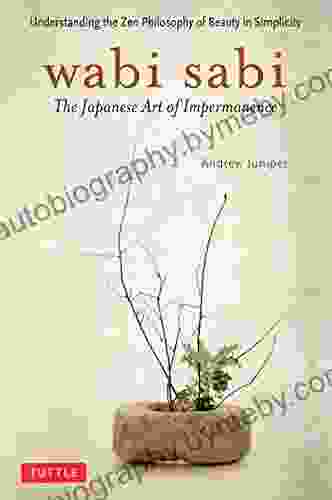Wabi Sabi: The Japanese Art of Impermanence

In a world often obsessed with perfection and permanence, the Japanese philosophy of wabi sabi offers a refreshing and transformative perspective. Wabi sabi celebrates the beauty of imperfection, the transience of life, and the profound interconnectedness of all things.
Origins of Wabi Sabi
Wabi sabi emerged in Japan during the 15th century, amidst a period of cultural and social upheaval. The term "wabi" originally referred to the rustic simplicity of rural life, while "sabi" denoted the patina of age and wear. Over time, wabi sabi evolved into a sophisticated aesthetic sensibility that permeated all aspects of Japanese culture, from tea ceremony to architecture.
4.5 out of 5
| Language | : | English |
| File size | : | 4906 KB |
| Text-to-Speech | : | Enabled |
| Screen Reader | : | Supported |
| Enhanced typesetting | : | Enabled |
| Word Wise | : | Enabled |
| Print length | : | 177 pages |
At its core, wabi sabi is a celebration of the imperfect, the impermanent, and the incomplete. It recognizes the beauty in the cracks and crevices, the faded colors, and the weathered surfaces that bear witness to the passage of time.
Key Characteristics of Wabi Sabi
Wabi sabi embraces several key characteristics that define its unique aesthetic and philosophical perspective:
- Impermanence: Wabi sabi recognizes the transient nature of all things. It encourages us to appreciate the beauty and fragility of each moment, knowing that it will inevitably pass.
- Imperfection: Wabi sabi embraces the beauty of imperfection. It celebrates the quirks, irregularities, and asymmetries that make each object or experience unique.
- Asymmetry: Wabi sabi often favors asymmetry over symmetry, finding beauty in unbalanced compositions and arrangements.
- Simplicity: Wabi sabi values simplicity and restraint. It eschews ornamentation and excess, focusing on the essential elements of design and experience.
- Naturalness: Wabi sabi draws inspiration from the natural world, finding beauty in the textures, colors, and forms of nature.
Embracing Wabi Sabi in Daily Life
The principles of wabi sabi can be applied to all aspects of our lives, from the way we decorate our homes to the way we approach our relationships. By embracing wabi sabi, we can cultivate a deeper appreciation for the present moment and find solace in the transitory nature of life.
Here are a few practical ways to incorporate wabi sabi into your daily routine:
- Create a wabi sabi-inspired home: Opt for natural materials, earthy colors, and simple furnishings. Embrace the imperfections of your home, such as cracks in the walls or faded paint, as reminders of the passage of time.
- Practice mindfulness: Pay attention to the present moment and appreciate the beauty of the everyday. Notice the subtle changes in nature, the imperfections in your surroundings, and the transience of your thoughts and emotions.
- Cultivate gratitude: Express gratitude for the people and things in your life, even the imperfect ones. Recognize the value of each moment and cherish the relationships you have.
- Accept change: Embrace the natural cycles of life and the inevitability of change. Let go of attachments and expectations, and allow yourself to flow with the currents of life.
Wabi sabi is a profound philosophy that offers a transformative path to finding beauty and meaning in the impermanence of life. By embracing the principles of wabi sabi, we can cultivate a deeper appreciation for the present moment, find solace in the ephemeral, and live a life of purpose and meaning.
**Relevant :**
**Image of a Japanese tea bowl with a cracked glaze:** This ancient tea bowl embodies the wabi sabi aesthetic, showcasing the beauty of imperfection and the passage of time.
4.5 out of 5
| Language | : | English |
| File size | : | 4906 KB |
| Text-to-Speech | : | Enabled |
| Screen Reader | : | Supported |
| Enhanced typesetting | : | Enabled |
| Word Wise | : | Enabled |
| Print length | : | 177 pages |
Do you want to contribute by writing guest posts on this blog?
Please contact us and send us a resume of previous articles that you have written.
 Book
Book Novel
Novel Page
Page Chapter
Chapter Text
Text Story
Story Genre
Genre Reader
Reader Library
Library Paperback
Paperback E-book
E-book Magazine
Magazine Newspaper
Newspaper Paragraph
Paragraph Sentence
Sentence Bookmark
Bookmark Shelf
Shelf Glossary
Glossary Bibliography
Bibliography Foreword
Foreword Preface
Preface Synopsis
Synopsis Annotation
Annotation Footnote
Footnote Manuscript
Manuscript Scroll
Scroll Codex
Codex Tome
Tome Bestseller
Bestseller Classics
Classics Library card
Library card Narrative
Narrative Biography
Biography Autobiography
Autobiography Memoir
Memoir Reference
Reference Encyclopedia
Encyclopedia Richard D Merritt
Richard D Merritt Bill Bennett
Bill Bennett Anita Ganeri
Anita Ganeri Ashley Christensen
Ashley Christensen Andrew Patrick Nelson
Andrew Patrick Nelson Quentin Tarantino
Quentin Tarantino Karen Siff Exkorn
Karen Siff Exkorn Amy Timberlake
Amy Timberlake Charlotte Elkins
Charlotte Elkins Anlor Davin
Anlor Davin Amanda M Thrasher
Amanda M Thrasher R Edward Freeman
R Edward Freeman Andy Miller
Andy Miller Sharon Cameron
Sharon Cameron Amy Pickar Abernethy
Amy Pickar Abernethy Angelika Lukesch
Angelika Lukesch Angela Hunt
Angela Hunt Andy Crowe
Andy Crowe Jackie Alpers
Jackie Alpers Andrew Taylor
Andrew Taylor
Light bulbAdvertise smarter! Our strategic ad space ensures maximum exposure. Reserve your spot today!
 Josh CarterFollow ·18.3k
Josh CarterFollow ·18.3k Shawn ReedFollow ·19.8k
Shawn ReedFollow ·19.8k Herman MitchellFollow ·5.4k
Herman MitchellFollow ·5.4k Cruz SimmonsFollow ·7.2k
Cruz SimmonsFollow ·7.2k Devon MitchellFollow ·16k
Devon MitchellFollow ·16k Matt ReedFollow ·19.5k
Matt ReedFollow ·19.5k Enrique BlairFollow ·11.9k
Enrique BlairFollow ·11.9k Hamilton BellFollow ·9.8k
Hamilton BellFollow ·9.8k

 Bryce Foster
Bryce FosterCelebrate the Luck of the Irish: Unveiling Saint...
As the verdant hues of spring brush...

 Chase Simmons
Chase SimmonsCody Rodeo: A Photographic Journey into the Heart of the...
Step into the arena of the...

 David Mitchell
David MitchellUnveiling the Enchanting World of Door County Quilts: A...
Step into the Heart of Amish Country in...

 Floyd Powell
Floyd PowellCowboy Chatter: Unraveling the Enigmatic Tales of the Old...
Step into the...

 Ismael Hayes
Ismael HayesUnlock Content Marketing Mastery: How to Create...
In today's digital landscape, content is...

 Boris Pasternak
Boris PasternakMore Than 200 Hardball Questions For The Thinking Fan
The Ultimate Baseball Trivia Challenge Are...
4.5 out of 5
| Language | : | English |
| File size | : | 4906 KB |
| Text-to-Speech | : | Enabled |
| Screen Reader | : | Supported |
| Enhanced typesetting | : | Enabled |
| Word Wise | : | Enabled |
| Print length | : | 177 pages |












